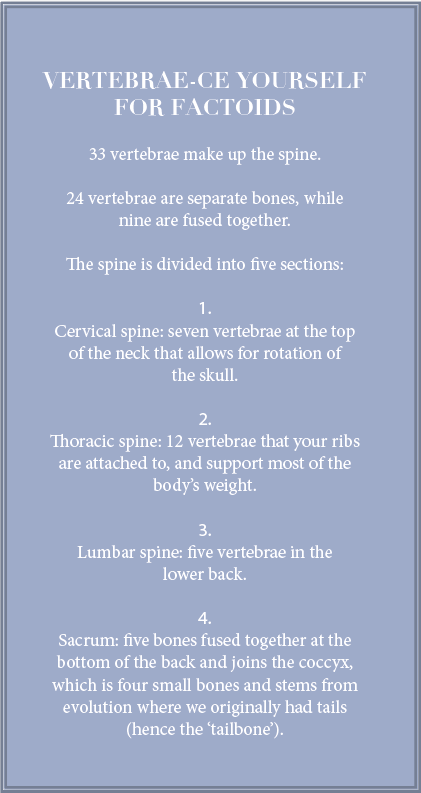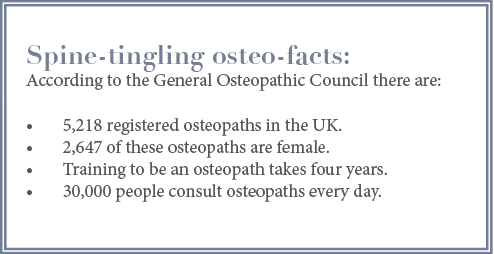Getting to grips with the complementary therapy that snaps healing into place
Back pain is one of the leading causes of time off work in the UK, accounting for about 30 million days of work lost in 2016. And it isn’t just painful for our bodies. According to the Backcare charity, back pain is hurting our wallets as well, costing the NHS an estimated £480 million every year. So what if there was an alternative, complementary therapy that could help both the physical pain, and our economy? Osteopathy, a holistic therapy you can feel (and sometimes hear) working, could be the answer.

Like many holistic therapies, osteopathy sees healing and good health connected to balance within the body. The basic principal is that the bones, muscles, ligaments and connective tissue should all be working smoothly, like a well-oiled machine, in order to achieve overall wellbeing. Osteopaths look to relieve tension in muscles, increase joint mobility, promote blood circulation, and generally help your body to heal, through physical manipulation. This can involve elements of stretching and massage, and is often used to treat musculoskeletal issues. It’s recommended by the National Institute for Health and Care Excellence (NICE) as a treatment for lower back pain, but it’s often also used to treat neck and shoulder pain, arthritis, problems caused by posture, and sports injuries.
Where did it start?
The therapy was founded in 1874 by Andrew Taylor Still, a physician and surgeon from Missouri, USA, who was interested in harmonising the body and the health benefits of doing this. He’s considered a real pioneer of “wellness”, and was looking at methods of treatment that minimised the need for surgery – considering that at the time surgery could actually be quite harmful, and three of his own children died from spinal meningitis. His concept was that doctors should be looking to treat the entire body of a patient, rather than just a disease or a specific problem.
In 1892, Still established the American School of Osteopathy, and his students were educated for two years in physiology and anatomy before graduating as Doctors of Osteopathy (DOs).
J Martin Littlejohn is noted for bringing osteopathy to Britain in 1913, after emigrating to America and studying under Still. When Littlejohn returned to Britain, he co-founded the British School of Osteopathy (BSO) and then the Journal of Osteopathy in 1917.
The British Osteopathic Association, formed in 1903, wanted to create a school that taught osteopathy alongside conventional medicine, but this view wasn’t shared with the BSO. It took until 1946 for them to form the London College of Osteopathic Medicine, which gave osteopathic courses to medical professionals, and meant graduates were the first British-trained osteopaths. Osteopathy wasn’t legally regulated until 1993 when the Osteopaths Act was finally introduced, which led to statutory regulation and professionals requiring registration with the General Osteopathic Council (GOsC) in order to practise as a qualified osteopath.

Scientific evidence
With back pain being the primary reason many people seek osteopathy, there are a reasonable number of studies with evidence to support the treatment’s efficacy in this area. Alex F Broom et al. detailed the results of an Australian longitudinal study in BMC Complementary Alternative Medicine in 2012. Their data were from more than 10,000 women surveyed about the use of conventional or complementary and alternative medicine (CAM) treatments over 12 months. They found that 77% of the women surveyed experienced back pain during those
12 months, and 44% consulted both conventional and CAM practitioners. Interestingly, women who had frequent back pain were more likely to consult a CAM practitioner.
There are claims that osteopathy can treat conditions not directly related to bones and joints, such as migraines, digestive disorders, and painful periods. However, there is insufficient scientific evidence to back these claims. There have been a few interesting studies researching these possible alternative treatments though.
A study by Manu Goyal et al. published in Contemporary Clinical Dentistry in 2017 found that osteopathic manipulative treatment was effective in treating a patient with oral submucous fibrosis, which is a chronic, progressive disease that leads to the inability to open one’s mouth. The case study found that while pharmacological treatment didn’t produce an effective result in the ability to open the mouth wider, the osteopathic treatment, given twice a week for four weeks (alongside a home exercise programme), had effective results, with the patient being able to increase his mouth opening from 10mm to 22mm by the end of the treatment course.
This study is certainly limited by being a single case, but demonstrates that there are possible further uses for osteopathic treatment beyond back pain, although significantly more research and investigation into its effectiveness is needed.
The Treatment
At the start of your treatment, the osteopath will talk through your medical history, the symptoms you currently have, and your general health, in order to make the most of your session. Based on your discussions, the osteopath should be able to describe the treatment they can provide, and whether they would refer you on to a GP for any tests to help assess your issue.

Osteopaths look to diagnose, treat and help prevent musculoskeletal disorders. The osteopath will use techniques such as massage to work tension from the muscles to promote relaxation. They’ll stretch out stiff joints, and use short, sharp movements (known as high-velocity thrusts) to the spine, which produce the “cracking” noise similar to clicking your knuckles. The overall aim is to reduce any pain in the body, improve the body’s movement ability, and encourage blood circulation.
While the treatment shouldn’t feel painful, it’s possible to feel a little stiff for a few days after your first treatment, particularly if you’re seeking treatment for a specific injury.
An initial treatment can last up to an hour, while continued treatments are likely to take between 30 and 40 minutes. The length of a treatment course will depend on the injury, however NICE recommends that lower back pain is treated in up to nine sessions over 12 weeks.
Osteopathy treatments aren’t widely available on the NHS, but your GP should be able to advise if it’s an option in your local area. Alternatively, there are lots of private osteopaths across the UK, ranging from around £35–£50 for a session.
To find out more about osteopathy treatment and how it could help you, visit Therapy Directory. You can also search for osteopaths in your local area to tackle that pain and get you back to your old self again.

Treatment Techniques
Osteopaths may use the following during a treatment session:
Soft tissue techniques: uses massage elements to release tension in anything that isn’t bone – muscles, tendons, ligaments and facia.
Joint mobilisation and articulation: uses rhythmic movement of your joints to stimulate blood flow.
Myofascial release: focuses on the fascial tissue around muscles then helps correct postural tension.
Cranial osteopathy: looks to balance fluid and membranous strains in the body with minute manipulations of the cranial bones. This technique is popular for helping babies sleep, as their bones are still soft and fusing, and it could help realign their spine from birth.
Thrust techniques: specifically targets joints with high velocity movements to help reset ligament and muscular strain patterns, returning your natural reflexes.
Functional techniques: uses subtle manipulation to improve the quality of movement. The technique sees movement in the body controlled by the brain and through the spinal column. By ensuring the vertebrae are aligned properly, for example, the neural pathway is clear for movement messages to flow.


Comments